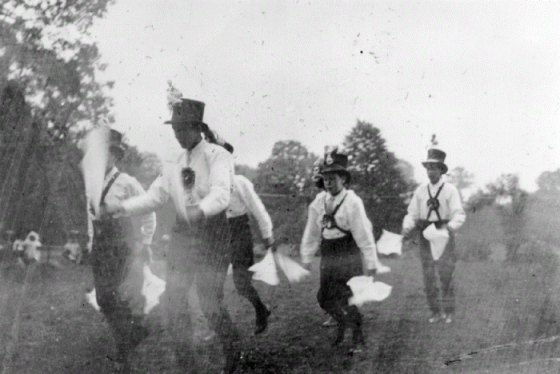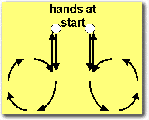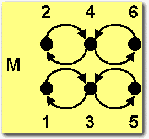Location:
North of Oxford and some 4 miles South of Banbury on the A423
Brief History of Tradition
Morris was danced in Adderbury unbroken until 1849. The side was eventually disbanded in 1880. Details were recorded by Janet Blunt, Cecil Sharp, and others, from discussions mainly with William Walton (a former Squire), from 1900 onwards. As some aspects of what was recorded are unclear, this has led to the so called 'interpretation debate'.
Most of the dances had words which were sung between dances as well as during. The music was always by pipe and tabor.
The tradition was revived in 1974 from the Sharp and Blunt manuscripts, and first danced publicly in 1975. It was introduced to the Icknield Way Morris Men in the late 70s by Old Boy Arthur Wright who was a member of the revival team.
Dances Performed by Our Side
Handkerchief Dances |
Stick Dances |
| Black Joke Stourton Wake |
Beaux of London City / Shooting Bluebells of Scotland Constant Billy Cuckoos Nest Happy Man Lads a' Bunchum Postman's Knock Shepherd's Hey Sweet Jenny Jones The Bell Washing Day |
Song Dance
Postman's Knock
|
|
Chorus: Verse for Foot Up and Half Gip: A wonderful man the postman is, he travels from door to door Chorus: Verse for Half Gip and Foot Down: At 1 he presents the news of a birth, and tidings of death number 4 Chorus: |
Characteristic Features of Tradition
| Notation |
Glossary of Terms |
GENERAL |
|
| Normal figures | x2FU, HG, PD, PU, HR and AddH. |
| Start | Normally face the music and walk round following a chord; sometimes singing. Sticks are held down pointing slightly in. Dance into place. |
| Hand/Arm Movements | Traditionally, opposite corners of the handkerchiefs were knotted over thumb and index finger. The pattern traced has been described as phallic in appearance
|
STEPS |
|
| Stepping | All dances are right foot start and, with few exceptions, is a normal double-step. Start of figures characterised by a 'thrust' |
| Side-Step - Open (sso) | Always open |
| Hop-Backs (hb) | Single-step, backwards movement into place. |
| Plain Capers (PC) | Leaps from one foot to the other taking on appearance of backwards cycling. |
FIGURES |
|
| Foot Up (FU) | Move up to the music and back, then repeat |
| Half-Gip (HG) | More like Side-by-Side. Pass right shoulders and return same side. Repeat left shoulders. |
| Processionals Down (PD) and Up (PU) | Move down (from musician) or up one position only. PD: first tops, then tops and middles (see diagram). PU: first bottoms, bottoms and middles.
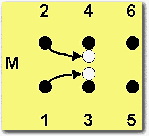 Processional Down 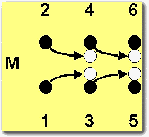 Processional Down |
| Half Rounds (hR) | First step is a moving step to opposite position, clasp partners right hand, step on the spot, and continue round. Reverse in second half. |
| Adderbury Hey (AddH) | The two lines of dancers move in parallel, tracing out a 'Figure of 8'.
|

